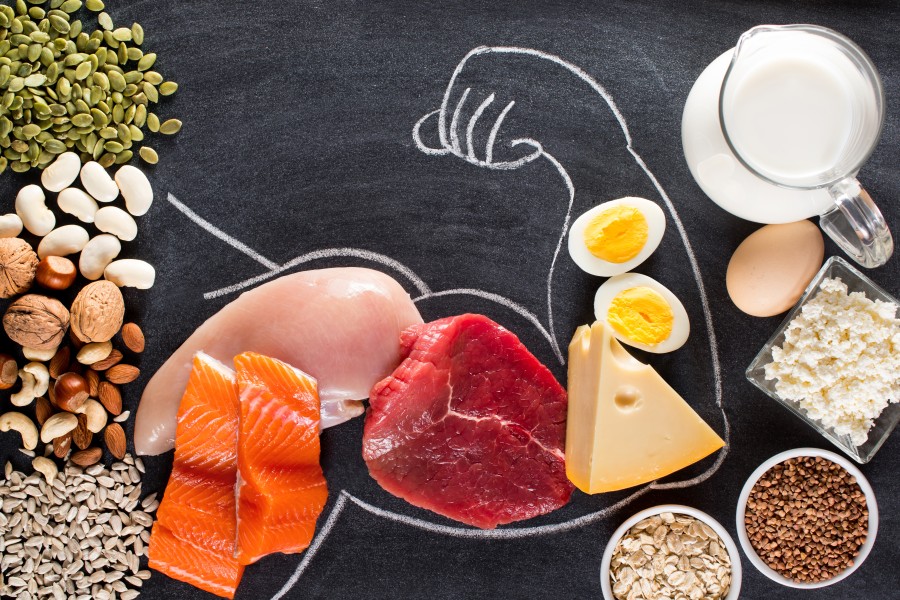Protein and type 1 diabetes

If you have type 1 diabetes, a balanced and varied diet is important to help with blood glucose management [1]. The key to getting the nutrition you need is eating a variety of foods containing all the major food groups — including protein [2].
It can seem quite daunting to ensure you have a mixed and varied diet that includes each food group throughout your meals, especially with a busy fast-paced lifestyle and also managing diabetes alongside that.
In this article, we’d like to focus on protein. It will hopefully help to guide and inform you on what protein is, how much you should try to have in your diet, and suggesting ingredients that you can easily include in your meals to get a balance of protein in your diet.
What is protein?
A protein is made of a string of building blocks called amino acids [3]. Proteins are everywhere in the body, making up a major part of the structure of muscles and other tissues [3]. Proteins also create the basis of a wide range of other essential molecules in the body, including hormones and enzymes [3].
We get protein from a variety of sources in our diet [3]. Protein can come from animal sources (i.e. eggs, milk, meat, fish and poultry) or from plant sources (such as vegetables, fruits, grains and legumes) [3].
Carbohydrates are not the only way that your body can generate the energy it needs — proteins can also be broken down and used as an energy source too [3].
How does protein affect type 1 diabetes?
When living with and managing type 1 diabetes, there is often more focus on carbs (carbohydrates) in meals. This is because carbohydrates turn into glucose in your body (to be used as energy), so they affect your blood glucose level more than other foods do [2, 3]. Carbs in food make your blood glucose levels go higher after you eat them than when you eat proteins or fats [4].
How much protein should someone with type 1 diabetes eat in a day?
Every person is different, and so the amount of protein or other food groups you need to reach your goals won’t be the same as someone else [5]. If you need some help or advice with your diet and maintaining your personal blood glucose range, you can discuss it with your GP or healthcare team.
There are many different ways to organise what you eat and meal planning can be really helpful [2]. There is one approach called the ‘plate’ method which is a simple visual way of understanding the nutritional portions you are eating [2].
For this, imagine that your plate is divided into sections, you could even buy a specific plate to help with this if you need. [2]. As a guide, you could aim to fill half of your plate with non-starchy vegetables (such as cauliflower, broccoli, cabbage, mushrooms or cucumber), one quarter of your plate with grains or starchy vegetables (such as rice, potatoes, parsnips, squash or pasta) and the remaining quarter filled with your chosen protein (like meats, fish, eggs, tofu or chickpeas) [2].
This is a rough idea of a general method you could follow, and it’s important to take into account any other health conditions or individual needs that you may have. You should try to focus on a balanced eating plan that works for you and your lifestyle, it should be something you can enjoy whilst being easy for you to maintain as best as you can.
Choosing proteins if you have type 1 diabetes
When you read some guidelines for managing diabetes or meal planning, you may find that many resources are much more focused on the carb and fat content of food. This is because carbohydrates are more associated with rising blood glucose [4], and eating more of certain types of fats can be associated with other health conditions [6].
There are lots of different options to choose from when including protein in your diet. Some good sources of protein include [2]:
- Lean meat
- Fish
- Eggs
- Nuts and peanuts
- Beans and some peas (such as chickpeas)
- Meat substitutes such as tofu
- Yogurt
It’s worth noting that while all of these foods are good sources of protein, they do also contain other things too so it’s worth reading the nutritional label, researching online or speaking to your healthcare team for more guidance on food content.
Does protein spike blood glucose?
Carbs are turned into glucose in the body and can therefore cause blood glucose to rise more quickly than other foods, such as proteins and fats [2, 4].
Due to this, current ways of calculating the dose of insulin mean you need to take focus on the carbohydrate content of the meal [7].
One study that looked at children with type 1 diabetes suggested high protein meals may lead to a rise in blood glucose, and that an increased dose of insulin might be needed to prevent hyperglycaemia (high blood glucose) [7].
However, there isn’t currently enough evidence regarding the impact of protein on blood glucose levels after eating, or clinical advice for optimal management of high-protein meals to say for certain [7].
Can someone with type 1 diabetes have protein shakes?

Protein shakes are consumed all the time for a variety of reasons, including when exercising, and by the general population to increase protein intake in a quicker and more concentrated way. It’s important to consider your own lifestyle and whether protein shakes would be right for you and if they are, what type and amount you will have. Some protein mixes will have a higher content of sugars and sweeteners to make them taste good too so it’s worth checking the ingredients. You can hop online to research different types, or chat to your GP or healthcare team about too.
One study has described how they are routinely used as part of the individual management plan to aid post-race recovery in elite athletes [8]. It’s important to remember that elite athletes and sports people usually have access to a team of specialist doctors, nurses and dieticians to create individual diet plans and training regimens just for them, so always do your own research and plan accordingly.
There is not currently any research into the use of protein shakes in people with type 1 diabetes who are not in intense training. If you are thinking of using protein shakes, then it might be helpful to firstly discuss this with your diabetes care team or even a dietician if you have access. They can advise you on alterations to your diet that will ensure you can continue maintaining your target blood glucose range.
Protein is a very important part of your diet but needs to be eaten as part of a balanced diet [2]. While we know that eating more carbs leads directly to raised blood glucose levels [4], the relationship between protein and blood glucose levels is less clear [5].
There are a number of sources of protein that you can include in your diet [2]. Your healthcare team will be able to give you more advice about how to include protein in your diet, and help you come up with meal plans that you can enjoy and fit your lifestyle.
If you would like to find out more about the relationship between meals and blood glucose or how to choose your foods, then our page on eating with diabetes can help.
Sources
- Davison, KAK, et al. Relationship between adherence to diet, glycemic control and cardiovascular risk factors in patients with type 1 diabetes: a nationwide survey in Brazil. Nutr J. 2014; 13: 19. https://doi.org/10.1186/1475-2891-13-19
- Diabetes diet, eating, and physical activity. National Institute of Diabetes and Digestive and Kidney Diseases. Accessed August 2022. Available at: https://www.niddk.nih.gov/health-information/diabetes/overview/diet-eating-physical-activity
- Hoffman JR, Falvo MJ. Protein - Which is Best? J Sports Sci Med. 2004;3(3):118-30
- Centers for Disease Control and Prevention (CDC). Manage Blood Sugar. Accessed August 2022. Available at: https://www.cdc.gov/diabetes/managing/manage-blood-sugar.html
- American Diabetes Association. Standards of medical care in diabetes- 2015. Diabetes Care 2015; 38(Suppl. 1): S1-S93
- Evert AB, et al. Nutrition therapy for adults with diabetes or prediabetes: a consensus report. Diabetes care. 2019;42:731-754
- Smart, CEM, et al. Both Dietary Protein and Fat Increase Postprandial Glucose Excursions in Children With Type 1 Diabetes, and the Effect Is Additive. Diabetes Care. 2013; 36 (12): 3897–3902. https://doi.org/10.2337/dc13-1195
- Fisher M, et al. Lessons from the professionals: diabetes and pro cycling. Practical diabetes. 2013; 30(7): 266-270
- International Diabetes Federation. IDF Diabetes Atlas (8th Ed). 2017
- Hansen HP, et al. Effect of dietary protein restriction on prognosis in patients with diabetic nephropathy. Kidney International. 2002; 62: 220–228


